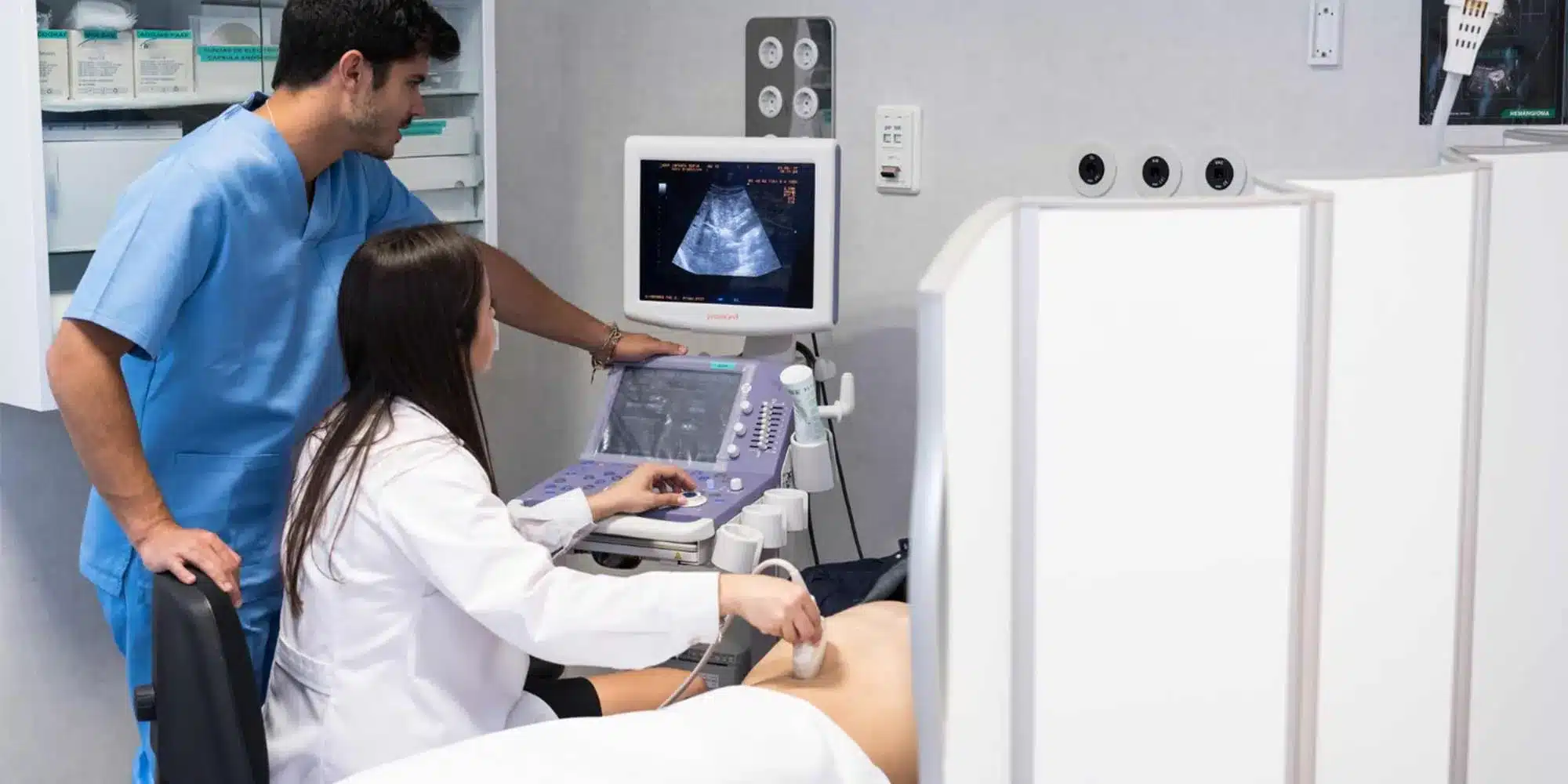TABLE OF CONTENT
- Understanding the Essence of an Ultrasound Scanning
- Purpose and Diverse Benefits of an Ultrasound Scanning
- Ultrasound Scans – A Pillar of Modern Healthcare
In the realm of medical wonders, imaging techniques play a pivotal role, and among them, the Ultrasound Scan emerges as a beacon of insight into the human body.
Understanding the Essence of an Ultrasound Scanning
At its core, an Ultrasound Scan is a non-invasive imaging method that employs sound waves to create detailed images of the internal structures within the body. Unlike other imaging techniques, there’s no exposure to radiation, making it a safe option for various medical purposes.
Purpose and Diverse Benefits of an Ultrasound Scanning

Diagnostic Clarity
The primary goal of an Ultrasound Scan is to provide detailed images for diagnostic and monitoring purposes. Its benefits include diagnostic clarity in evaluating a range of conditions, from pregnancy-related issues to abdominal organ abnormalities.
Ultrasound scans have become a cornerstone in the diagnostic process because they can visualise soft tissues, organs, and blood flow in real time. This real-time imaging capability sets ultrasound apart, offering a dynamic perspective that aids in identifying and characterising various medical conditions.
Pregnancy Monitoring
For expectant parents, Ultrasound Scans offer an enchanting glimpse into the development of their unborn child, providing crucial information about the baby’s health and well-being. The intricate details captured during these scans serve as a diagnostic tool and an emotional connection for parents.
Obstetric ultrasound, a specialised form of ultrasound, monitors foetal development during pregnancy. It has evolved to become an indispensable tool in prenatal care, allowing healthcare professionals to assess the foetus’s growth, position, and overall health.
Guidance for Interventions
Like MRI, Ultrasound is increasingly used to guide medical procedures like biopsies, ensuring precision and accuracy. It expands its utility beyond mere diagnosis to becoming a valuable tool in medical interventions.
The real-time guidance ultrasound provides during interventions enhances the accuracy and safety of procedures. Whether guiding a needle for a biopsy or assisting in drainage procedures, ultrasound ensures that medical interventions are conducted precisely.
Navigating Through an Ultrasound Scan Procedure
Preparation
Preparation is minimal; usually, it involves wearing loose-fitting clothing and, in some cases, fasting for a few hours before the scan. This straightforward preparation ensures that the patient can comfortably undergo the procedure.
The Ultrasound Procedure Itself
As you lie comfortably on a bed, a gel is applied to the skin, and a handheld device (transducer) is moved over the designated area. You may feel slight pressure, but the process is generally painless. The simplicity of the procedure contributes to its widespread acceptance and application in various medical fields.
The transducer emits high-frequency sound waves, which bounce off internal structures and create echoes. These echoes are then converted into detailed images, providing healthcare professionals valuable insights into the examined area.
Duration
Ultrasound scans are typically quick, lasting between 15 to 45 minutes, depending on the examined area. This efficiency adds to the appeal of ultrasound as a diagnostic tool, especially in settings where time is of the essence.
The relatively short duration of Ultrasound scans makes them feasible in various clinical settings, from busy hospitals to outpatient clinics. Quick turnaround times ensure patients receive prompt results, allowing for timely decisions regarding further medical management.
Exploring the Diverse Types of Ultrasound Scans

The versatility of ultrasound extends to various types, each serving a specific purpose:
Obstetric Ultrasound
Focused on monitoring foetal development, this type is a highlight during pregnancy. The ability to track the growth and well-being of the unborn child is paramount, making obstetric ultrasound a critical component of prenatal care.
Obstetric ultrasound goes beyond traditional 2D imaging, offering advanced 3D and 4D imaging techniques. These technologies provide a more comprehensive view of the foetus, aiding in the early detection of abnormalities and enhancing the overall understanding of foetal development.
Abdominal Ultrasound
Examining the organs in the abdomen helps detect conditions like gallstones and liver diseases. The detailed images provided by abdominal ultrasound contribute significantly to accurate diagnoses in gastroenterology and hepatology.
Abdominal ultrasound is a versatile tool for evaluating various organs, including the liver, gallbladder, pancreas, and kidneys. It plays a crucial role in the detection of conditions such as liver cirrhosis, gallbladder stones, and pancreatic abnormalities. The non-invasive nature of abdominal ultrasound makes it a preferred choice for initial assessments and routine screenings.
Cardiac Ultrasound
Cardiac ultrasound assesses the heart’s structure and function, aiding in diagnosing heart conditions. Cardiac Ultrasound is a non-invasive method to evaluate cardiac health, providing valuable information for cardiologists and other healthcare professionals.
Cardiac Ultrasound, or echocardiography, enables detailed visualisation of the heart’s chambers, valves, and blood flow patterns. It plays a vital role in diagnosing heart valve disorders, congenital heart defects, and heart muscle abnormalities. The ability to assess cardiac function without invasive procedures makes cardiac ultrasound a valuable diagnostic tool in cardiology.
Embracing the Advantages of Open Ultrasound Machines
Acknowledging patient comfort, some facilities offer ‘open’ Ultrasound machines, providing a more relaxed environment, especially for those prone to anxiety or claustrophobia. This patient-centric approach enhances the overall experience and encourages individuals to undergo necessary scans without stress.
Open Ultrasound machines address the common concerns associated with traditional closed devices, such as feelings of confinement and anxiety. The available design gives patients a more comfortable and less intimidating experience, promoting better cooperation during the procedure. This consideration for patient well-being contributes to a positive overall healthcare experience.
Ultrasound Scan: Beyond Diagnosis to Precision Interventions
Besides its diagnostic role, ultrasound plays a crucial part in guiding interventions. From surgeries to minimally invasive procedures, real-time Ultrasound scans contribute to precision and effectiveness. The dynamic nature of Ultrasound imaging ensures that medical professionals can navigate with accuracy, enhancing the success rates of various interventions.
Real-time guidance ultrasound is invaluable in various medical interventions, ranging from the placement of central venous catheters to joint injections. Visualising anatomical structures in real-time enhances procedural accuracy, reducing the risk of complications and improving patient outcomes. As technology advances, the applications of real-time Ultrasound guidance continue to expand across different medical specialities.
Cost and Accessibility
For many, the cost of medically necessary Ultrasound Scans is covered by healthcare services. However, private facilities may involve out-of-pocket expenses. Availability, including ‘open’ machines, varies, emphasising the importance of checking with healthcare providers. Understanding the financial aspects ensures that individuals can make informed decisions regarding their healthcare.
The cost of Ultrasound scans can vary based on factors such as geographic location, the type of facility, and the specific type of ultrasound needed. While some healthcare providers offer coverage for medically necessary Ultrasound scans, individuals should be aware of potential out-of-pocket costs. Exploring options and discussing financial considerations with healthcare providers can help individuals navigate the cost landscape and ensure access to necessary diagnostic procedures.
Ultrasound Scans – A Pillar of Modern Healthcare
With their simplicity and effectiveness, ultrasound scans stand as an integral part of modern healthcare. As technology advances, the role of ultrasound in patient care becomes even more significant, ensuring a path towards a healthier future. The non-invasive nature and diverse applications across medical specialities solidify ultrasound as a cornerstone in diagnostic and interventional medicine.
In conclusion, the multifaceted benefits of Ultrasound scans, ranging from diagnostic clarity to guiding precision interventions, underscore their indispensability in contemporary healthcare. The ongoing advancements in Ultrasound technology promise continued improvements in imaging quality and diagnostic accuracy, further enhancing their role in patient care. As individuals navigate their healthcare journey, understanding the intricacies of Ultrasound scans empowers them to make informed decisions, promoting proactive health management.




